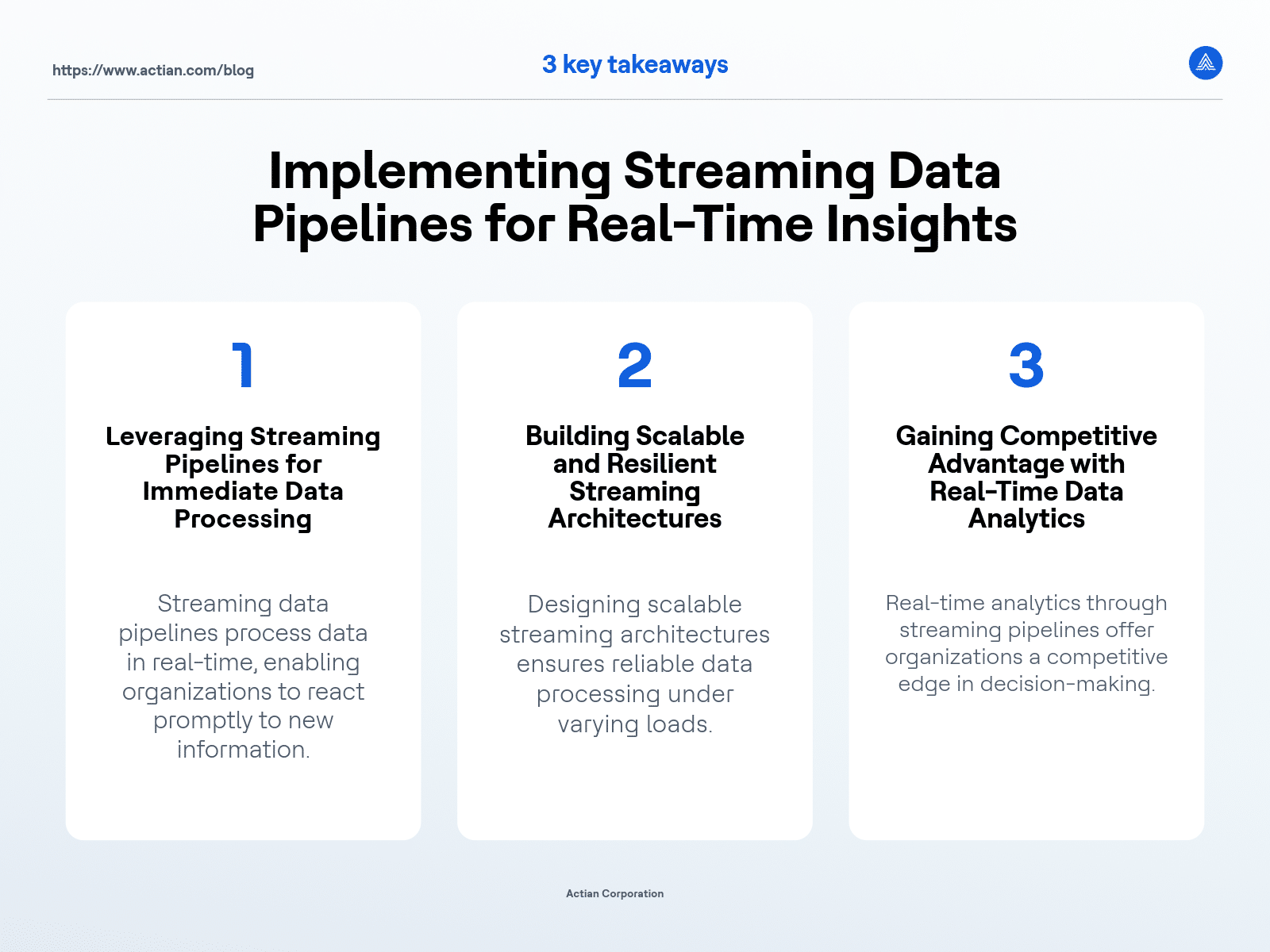Streaming data pipelines are rapidly becoming essential tools for modern businesses that require fast, real-time data processing. These days, companies receive data from many different sources — ranging from mobile devices to cloud services — and efficient streaming pipelines help them receive the crucial, timely data they need to ensure business success. From mobile banking and GPS applications to real-time fraud detection and predictive maintenance use cases, organizations worldwide rely on these pipelines for timely insights and actions that drive their businesses.
In this comprehensive guide, we’ll explore what streaming data pipelines are, how they work, their benefits, and more. Let’s dive in.
What Are Streaming Data Pipelines?
A streaming data pipeline is a system that continuously processes and transfers data in real time. Unlike traditional batch processing pipelines that work with static datasets, streaming pipelines handle data-in-motion, performing real-time analytics and transformations as the data arrives.
These pipelines capture data from various sources, process it immediately, and deliver it without waiting for the data collection process to finish. Streaming data pipelines are crucial to businesses that need data fast and can’t afford to wait for long processing times.
How Do Streaming Pipelines Work?
Data has several touchpoints as it travels through streaming pipelines. To help explain how these pipelines work, here is how data flows from sources to end users:
- Data Sources: These include IoT devices, applications, websites, databases, and third-party APIs that generate continuous data streams.
- Data Ingestion: Tools like Apache Kafka ingest real-time streaming data by capturing and transferring it to the pipeline for processing.
- Real-Time Data Analytics: This involves transforming and analyzing data in real time using frameworks like Flink or Spark Streaming.
- Data Storage: Processed data is often stored in databases or data lakes to support real-time analytics and future queries.
- Data Consumers: The processed data is made available to applications, dashboards, machine learning algorithms, or other users that consume it in real-time and present it to data stewards.
Streaming Data Pipelines vs. Traditional ETL
Traditional extract, transform, and load (ETL) processes typically use batch processing. This is when data is collected over a period of time, transformed, and loaded into a target system. In contrast, streaming ETL pipelines apply transformations and load data as it is produced, enabling immediate analysis and decision-making. This is critical for applications like financial fraud detectors, which need to process data in milliseconds rather than hours.

Benefits of Streaming Data Pipelines
Streaming data pipelines offer several advantages for organizations that need fast, efficient data processing. Here are five key benefits:
1. Improved Decision-Making
Streaming pipelines enable real-time insights, allowing companies to make data-driven decisions at the speed of business. For example, financial institutions can detect fraud as transactions happen, preventing losses in real time.
2. Reduced Latency
By processing data as it arrives, streaming pipelines significantly reduce the lag between data generation and data consumption. This is crucial in industries like healthcare, where a second can make the difference between life and death.
3. Agility and Scalability
Streaming pipelines are highly scalable depending on business needs, making it easy to adjust to fluctuating data volumes. Whether organizations are dealing with a handful of data sources or millions, cloud-native data pipelines can handle the load efficiently.
4. Fault Tolerance
Fault tolerance is the ability of a data system to continue running if one of its parts fails. Many streaming tools — like DataFlow — support fault tolerance so that the pipeline continues to operate smoothly even when components fail.
5. Cost Efficiency
Real-time data processing allows businesses to identify inefficiencies and optimize operations on the go, leading to cost savings over time. Processing smaller data chunks in real time can also reduce the need for larger storage compared to batch processing.
Best Practices for Streaming Data Pipeline Architectures
Designing a high-performing streaming data pipeline starts with a carefully constructed architecture. Here are some considerations when creating one:
Streaming vs. Batch Processing
While batch processing is helpful for some analytical workloads, streaming pipelines are a great option when low-latency data processing is needed. However, hybrid architectures that use both batch and streaming can sometimes be the best approach by offering the advantages of each.
Decentralized Data Management
Modern streaming architectures benefit from a decentralized approach to data management. Instead of relying on a central data warehouse, organizations can manage and process data in motion across different cloud-native data lakes for greater agility.
Declarative Languages
Using languages like SQL for streaming data pipelines simplifies their design and maintenance. This approach allows developers to focus on what the pipeline should do rather than how it should be done.
Continuous Integration/Continuous Delivery (CI/CD)
Incorporating CI/CD pipelines into data flows is crucial for maintaining high availability and performance in streaming pipelines. Regular testing, deployment automation, and monitoring ensure that changes to the pipeline are implemented safely and efficiently.
Data Governance
Implementing proper data governance policies is essential to ensure data quality and compliance. When creating a data governance architecture that includes streaming pipelines, it’s important to track data lineage, ensure privacy, and meet data compliance laws.
How to Implement and Integrate Streaming Data Pipelines
Once organizations have created a solid architecture for their pipelines, it’s time to integrate them into the data system and put them to work. Here’s a step-by-step guide to help with data integration:
1. Assess the Infrastructure
Before implementing pipelines, evaluate the current infrastructure to ensure it’s compatible with the demands of real-time data processing. Consider the network’s capacity, storage requirements, and ability to scale.
2. Choose the Right Tools
Selecting the right platform is critical for the success of the pipeline. Apache Kafka and Actian DataFlow are popular choices, offering robust features for data streaming, fault tolerance, and scalability. Actian DataFlow, in particular, provides powerful real-time analytics and implementation capabilities, making it easier to handle complex data flows.
3. Standardize Schema
Standardizing the data schema ensures consistent data formats across various systems, which helps reduce errors and ensures smooth integration between different parts of the streaming pipeline.
4. Real-Time Monitoring and Alerts
Streaming pipelines need real-time monitoring to detect bottlenecks, failures, or performance issues. Set up alerts that notify stakeholders of potential problems before they impact the overall health of the pipeline.
5. Deployment
Finally, deploy the streaming pipeline using cloud-native services or on-premises solutions, depending on the organization’s needs. Ensure that CI/CD processes are in place for future updates and maintenance.

Common Challenges and How to Overcome Them
Building and maintaining streaming data pipelines can present challenges. Here’s how to address some of the most common ones:
Data Consistency
Ensuring consistency across multiple streaming systems can be difficult, especially when dealing with distributed data. Implementing exactly-once processing and using event sourcing patterns can help.
High Data Volumes
Managing large volumes of data in real time can overload pipelines. To reduce the risk, use sharding or partitioning to break the data into manageable chunks and improve processing efficiency.
Low Latency Requirements
Achieving low latency can be a challenge, particularly when data must traverse multiple systems. Optimize the pipeline using in-memory processing frameworks like Apache Flink and reduce unnecessary hops between systems.
Balancing Processing Needs
Some data requires complex processing, which can slow down the pipeline. To balance performance, consider using microservices architectures to distribute the workload.
Successful Streaming Data Pipeline Use Cases
Streaming data lends itself well to a range of real-world use cases. These include:
Detect Fraud Faster for Financial Services
Banks and payment processors rely heavily on streaming data pipelines for fraud detection and real-time analytics. By analyzing transaction data as transactions occur, financial institutions can identify and block fraudulent activities.
Enable Real-Time Patient Monitoring in Healthcare
In the healthcare industry, streaming pipelines power real-time patient monitoring systems. For example, heart rate monitors and other IoT devices stream data to cloud-based systems where AI algorithms can immediately detect abnormalities and alert medical staff.
Deliver Personalized Recommendations in Retail
Retailers use streaming pipelines to power personalized customer recommendation engines. By analyzing buying patterns and preferences in real time, companies like Amazon can make instant product suggestions that drive sales.
Streamline Streaming Pipelines
Streaming data pipelines are powerful tools for organizations that need to process and analyze data in real time. They represent the future of data processing, delivering insights faster than ever before. From financial services to healthcare and retail, they enable businesses to respond to events instantly, improve decision-making, and increase operational efficiency.
By following best practices for an architecture, overcoming challenges, and choosing the right tools, organizations can build scalable, reliable, and efficient streaming pipelines. When selecting tools, opt for a unified data platform for real-time insights that’s easy to implement and use, is highly customizable, doesn’t require coding, and has high throughput.
DataFlow, offered in the Actian Data Platform, features all these benefits and more — request a demo today to see how it can help process data in motion to drive business performance. Also check out our free eBook How to Maximize Business Value With Real-Time Data Analytics for more implementation tips.
Key Takeaways

Subscribe to the Actian Blog
Subscribe to Actian’s blog to get data insights delivered right to you.
- Stay in the know – Get the latest in data analytics pushed directly to your inbox
- Never miss a post – You’ll receive automatic email updates to let you know when new posts are live
- It’s all up to you – Change your delivery preferences to suit your needs
